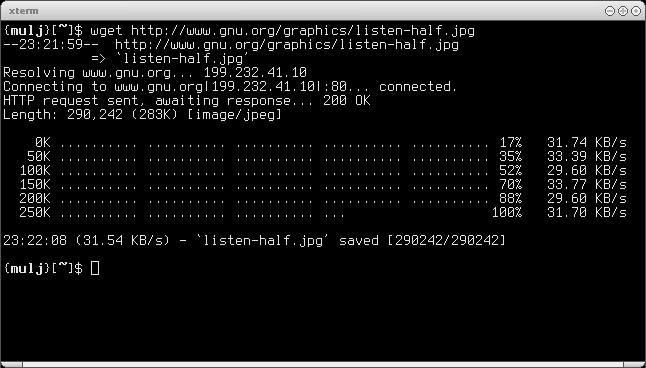单线程传输命令行工具——wget命令
 [root@AY140716161543837722Z ~]# wget -h
[root@AY140716161543837722Z ~]# wget -h
GNU Wget 1.12, a non-interactive network retriever.
Usage: wget [OPTION]... [URL]...
Mandatory arguments to long options are mandatory for short options too.
Startup:
-V, --version display the version of Wget and exit.
-h, --help print this help.
-b, --background go to background after startup.
-e, --execute=COMMAND execute a ‘.wgetrc’-style command.
Logging and input file:
-o, --output-file=FILE log messages to FILE.
-a, --append-output=FILE append messages to FILE.
-d, --debug print lots of debugging information.
-q, --quiet quiet (no output).
-v, --verbose be verbose (this is the default).
-nv, --no-verbose turn off verboseness, without being quiet.
-i, --input-file=FILE download URLs found in local or external FILE.
-F, --force-html treat input file as HTML.
-B, --base=URL resolves HTML input-file links (-i -F)
relative to URL.
Download:
-t, --tries=NUMBER set number of retries to NUMBER (0 unlimits).
--retry-connrefused retry even if connection is refused.
-O, --output-document=FILE write documents to FILE.
-nc, --no-clobber skip downloads that would download to
existing files.
-c, --continue resume getting a partially-downloaded file.
--progress=TYPE select progress gauge type.
-N, --timestamping don’t re-retrieve files unless newer than
local.
-S, --server-response print server response.
--spider don’t download anything.
-T, --timeout=SECONDS set all timeout values to SECONDS.
--dns-timeout=SECS set the DNS lookup timeout to SECS.
--connect-timeout=SECS set the connect timeout to SECS.
--read-timeout=SECS set the read timeout to SECS.
-w, --wait=SECONDS wait SECONDS between retrievals.
--waitretry=SECONDS wait 1..SECONDS between retries of a retrieval.
--random-wait wait from 0...2*WAIT secs between retrievals.
--no-proxy explicitly turn off proxy.
-Q, --quota=NUMBER set retrieval quota to NUMBER.
--bind-address=ADDRESS bind to ADDRESS (hostname or IP) on local host.
--limit-rate=RATE limit download rate to RATE.
--no-dns-cache disable caching DNS lookups.
--restrict-file-names=OS restrict chars in file names to ones OS allows.
--ignore-case ignore case when matching files/directories.
-4, --inet4-only connect only to IPv4 addresses.
-6, --inet6-only connect only to IPv6 addresses.
--prefer-family=FAMILY connect first to addresses of specified family,
one of IPv6, IPv4, or none.
--user=USER set both ftp and http user to USER.
--password=PASS set both ftp and http password to PASS.
--ask-password prompt for passwords.
--no-iri turn off IRI support.
--local-encoding=ENC use ENC as the local encoding for IRIs.
--remote-encoding=ENC use ENC as the default remote encoding.
Directories:
-nd, --no-directories don’t create directories.
-x, --force-directories force creation of directories.
-nH, --no-host-directories don’t create host directories.
--protocol-directories use protocol name in directories.
-P, --directory-prefix=PREFIX save files to PREFIX/...
--cut-dirs=NUMBER ignore NUMBER remote directory components.
HTTP options:
--http-user=USER set http user to USER.
--http-password=PASS set http password to PASS.
--no-cache disallow server-cached data.
--default-page=NAME Change the default page name (normally
this is ‘index.html’.).
-E, --adjust-extension save HTML/CSS documents with proper extensions.
--ignore-length ignore ‘Content-Length’ header field.
--header=STRING insert STRING among the headers.
--max-redirect maximum redirections allowed per page.
--proxy-user=USER set USER as proxy username.
--proxy-password=PASS set PASS as proxy password.
--referer=URL include ‘Referer: URL’ header in HTTP request.
--save-headers save the HTTP headers to file.
-U, --user-agent=AGENT identify as AGENT instead of Wget/VERSION.
--no-http-keep-alive disable HTTP keep-alive (persistent connections).
--no-cookies don’t use cookies.
--load-cookies=FILE load cookies from FILE before session.
--save-cookies=FILE save cookies to FILE after session.
--keep-session-cookies load and save session (non-permanent) cookies.
--post-data=STRING use the POST method; send STRING as the data.
--post-file=FILE use the POST method; send contents of FILE.
--content-disposition honor the Content-Disposition header when
choosing local file names (EXPERIMENTAL).
--auth-no-challenge send Basic HTTP authentication information
without first waiting for the server’s
challenge.
HTTPS (SSL/TLS) options:
--secure-protocol=PR choose secure protocol, one of auto, SSLv2,
SSLv3, and TLSv1.
--no-check-certificate don’t validate the server’s certificate.
--certificate=FILE client certificate file.
--certificate-type=TYPE client certificate type, PEM or DER.
--private-key=FILE private key file.
--private-key-type=TYPE private key type, PEM or DER.
--ca-certificate=FILE file with the bundle of CA’s.
--ca-directory=DIR directory where hash list of CA’s is stored.
--random-file=FILE file with random data for seeding the SSL PRNG.
--egd-file=FILE file naming the EGD socket with random data.
FTP options:
--ftp-user=USER set ftp user to USER.
--ftp-password=PASS set ftp password to PASS.
--no-remove-listing don’t remove ‘.listing’ files.
--no-glob turn off FTP file name globbing.
--no-passive-ftp disable the “passive” transfer mode.
--retr-symlinks when recursing, get linked-to files (not dir).
Recursive download:
-r, --recursive specify recursive download.
-l, --level=NUMBER maximum recursion depth (inf or 0 for infinite).
--delete-after delete files locally after downloading them.
-k, --convert-links make links in downloaded HTML or CSS point to
local files.
-K, --backup-converted before converting file X, back up as X.orig.
-m, --mirror shortcut for -N -r -l inf --no-remove-listing.
-p, --page-requisites get all images, etc. needed to display HTML page.
--strict-comments turn on strict (SGML) handling of HTML comments.
Recursive accept/reject:
-A, --accept=LIST comma-separated list of accepted extensions.
-R, --reject=LIST comma-separated list of rejected extensions.
-D, --domains=LIST comma-separated list of accepted domains.
--exclude-domains=LIST comma-separated list of rejected domains.
--follow-ftp follow FTP links from HTML documents.
--follow-tags=LIST comma-separated list of followed HTML tags.
--ignore-tags=LIST comma-separated list of ignored HTML tags.
-H, --span-hosts go to foreign hosts when recursive.
-L, --relative follow relative links only.
-I, --include-directories=LIST list of allowed directories.
-X, --exclude-directories=LIST list of excluded directories.
-np, --no-parent don’t ascend to the parent directory.
Mail bug reports and suggestions to <[email protected]>.
[root@AY140716161543837722Z ~]#
wget 网址而要让档案自动储存到指令的目录下,则需要借用-P这个参数 可以使用以下的指令 wget -P 目录 网址 举例来说,如果你要将某个网址的文件下载之后存放到/root底下,你可以打下列的指令: wget -P /root 网址
GNU Wget是一个在网络上进行下载的简单而强大的自由软件,其本身也是GNU计划的一部分。它的名字是“World Wide Web”和“Get”的结合,同时也隐含了软件的主要功能。目前它支持通过HTTP、HTTPS,以及FTP这三个最常见的TCP/IP协议协议下载
主要特点包括:
支持递归下载
恰当的转换页面中的链接
生成可在本地浏览的页面镜像
支持代理服务器
1996年,随着互联网的爆发,Wget出现了。并广泛的被Unix和主要的Linux发行版用户所使用。由于使用移植性非常良好的C语言,所以Wget可以轻松的在任何类似Unix的系统以及其他Unix变种操作系统上编译使用,如Mac OS X,Microsoft Windows[1],和OpenVMS[2]。
由于没有交互式界面,在类Unix平台上Wget可在后台运行,截获并忽略HANGUP信号,因此在用户退出登录以后,仍可继续运行。通常,Wget用于成批量地下载Internet网站上的文件,或制作远程网站的镜像。
在其之上的图形界面应用程序有:GNOME下面的gwget[3]。Windows系统下面的wGetGUI[4]。